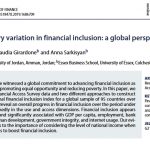
EMNES Working paper 026
This paper proposes a comprehensive assessment of the effect of different trade barriers (tariffs, non-tariff measures and services restrictions) on wages in the Middle East and North Africa (MENA) region. These disparities are studied in four dimensions: wage premiums, gender (males versus females), qualification (skilled versus unskilled), and regional (urban versus rural workers). We use three datasets, which are the Egyptian Labour Market Panel Survey (2012), the Jordanian Labour Market Panel Survey (2010) and the Tunisian Labour Market Panel Survey (2014). Following Goldberg and Pavnick (2004) and Zaki (2013), we directly assess the effect of trade policy on wage disparity using the human capital model (Mincer, 1974) to which different trade barriers are added. Our results suggest that, in general, the effect of services restrictions and non-tariff measures are much stronger than that of tariffs on wage premium. When we look at different segments, we find that females are more affected by non-tariff measures than their male counterparts. At the skill level, and given the abundance of blue collar workers in the MENA region, production workers are less affected by both non-tariff measures and by services restrictions than non-production workers, but are more affected by tariffs. Finally, all trade barriers do not have a differential effect on urban vs. rural workers.





